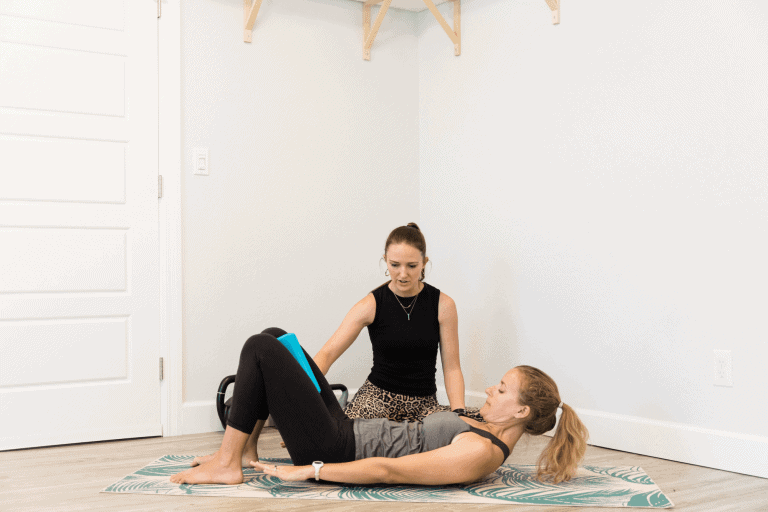There is a lot of cultural pressure to get back to your “pre-baby body” 3 seconds after blissfully pushing out a baby in a candlelit water birth. Let me be clear: I am not here to further that pressure.
However, because you’re here, I think we can safely say you care about exercise — maybe even love it — and so you’re probably eager to get back to doing everything you could before having a baby. I feel that!
And also, I need you to know that rushing or skipping the appropriate progressions can ultimately lead to injury and taking longer to get where you want to be.
When Can You Start Postpartum Workouts?
Traditionally in the United States, women have been cleared for exercise at their 6-week postpartum visit with the doctor. In fact, there is no particular reason why 6 weeks is the benchmark, and the American College of Obstetrics and Gynecology (ACOG) actually recommends postpartum workouts as soon as a few days after giving birth for some women.
Yes, you read that right: A few days. This post on when we can begin postpartum workouts goes into where the myth of 6 weeks came from and how to know when it’s appropriate for YOU to begin working out again.
Before You Start Postpartum Workouts: What to Look For
Postpartum is all about reacquainting yourself with your body and getting really good at knowing if something is awry.
That said, it’s essential that you FIRST, make sure you don’t have any obvious core or pelvic floor dysfunctions described below. Then you begin practicing a very gentle and progressive program — no matter when you start! (Meaning, you need to progress gradually whether you’re starting at 2 weeks, 2 months, or 2 years postpartum.)
Finally, rely on your medical professional for final clearance before moving back into mainstream exercise. As described in the article linked above, ACOG advises gentle exercise for those who’ve had normal births as early as a few days postpartum. However, if you had a complicated or surgical birth, seek professional guidance before starting any activity again.
Common Postpartum Core & Pelvic Floor Dysfunctions
Ready for the doom and gloom section? Woohoo! Here are some of the most common postpartum dysfunctions to look out for:
Diastasis Recti (DR)
Your 6-pack muscles (aka rectus abdominis) connect down the center at your linea alba (picture what the 6-pack looks like in an anatomy book; the linea alba is the white line that runs down the center — this is discussed in more detail in Chapter 12). This line of connective tissue naturally separates while pregnant – this is necessary and normal! After pregnancy, the tissue may not return to its normal position. This is called a diastasis recti.
A DR is measured by the finger widths of separation between the two sides of your 6-pack muscles. However, it is also important to pay attention to what the connective tissue feels like — we want springy and firm, not soft, bottomless marshmallow. If your gap is much wider than 2 fingers (as in, not “just barely sorta two fingers” but actually several centimeters across) or if you have other DR symptoms, like low-back pain, doming or coning of the ab muscles when you use them, or urinary incontinence, talk to your provider.
Hernia
An umbilical hernia (at the belly button) almost always occurs in tandem with a DR. This happens when the organs press through a weak spot in the connective tissue and bulge out. Umbilical hernias are most common after pregnancy, but there are also inguinal, hiatal, and epigastric hernias (though these are rare as a result of pregnancy). The recovery work for an umbilical hernia is the same as with a DR, though they may need to be repaired surgically. See a doctor before doing any core work.
Pelvic Organ Prolapse (POP)
Pelvic organ prolapse happens when the muscles and tissues supporting the pelvic organs (the uterus, bladder, or rectum) become weak or loose. This allows one or more of the pelvic organs to drop or press into or out of the vagina. You may hear terms like cystocele, rectocele, and enterocele to describe the different types. This may happen in tandem with episiotomy or tearing, but can also happen independently weeks or months after pregnancy if you exercise too hard too quickly.
POP can feel like a heaviness or pain in the pelvis around the vagina/cervix. If you look, things may also look different on the outside. POP is exacerbated by perma-squeezing the ab muscles or using the core without appropriate pelvic floor support. Instead, focus on engaging the pelvic floor muscles on the exhale and relaxing them on the inhale. (And see a pelvic floor PT or a physician!)
Incontinence
Incontinence is any release of urine (more common after pregnancy) or feces outside of when intentionally eliminating. This includes even a small amount of “leaking” when laughing, jumping, sneezing, or lifting. Do not let anyone tell you this is your new normal! It may be common but that doesn’t mean you have to live with it. Start with the exercise progressions discussed here and if you’re not seeing progress, see a pelvic floor PT.
Pelvic Pain or Pain During Intercourse
Again, do not let anyone tell you this is your new normal. (Or “Just have a glass of wine and get over it.”) Try the exercises described below under the “too tight pelvic floor” and if that doesn’t work, see a pelvic floor PT and figure out what’s going on.
Your Postpartum Workout Plan
I saw an awesome post over on Instagram that listed the 5 most important postpartum exercises as:
- Sleep
- Eat
- Snuggle baby
- Rest/recover
- Breathe
Yeah, pretty much. I’m pretty strict that if you’re not doing those things, I don’t want you adding more to your plate.
But let’s say you’ve got those bases covered. Next, you postpartum workouts should include: stretching and massage for areas impacted by pregnancy and childcare, restrengthening the core and pelvic floor, maintaining mobility in the core and pelvic floor, and ensuring that all the major joints (think: shoulders, knees, hips) are working properly and ready to handle to demand of more strenuous workouts.
When I train people postpartum, we re-learn how to breathe (including how to breathe during movement), how to engage the core and pelvic floor, posture, and how to actually relax.
If you’re ready to get back to doing whatever exercise you love most in 3 months or your money back, join my Postpartum Workout program, RECLAIM. If you think you need something more custom, book a wellness consult and I’ll see what I can do for you.

